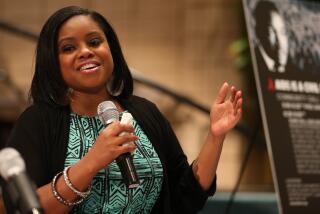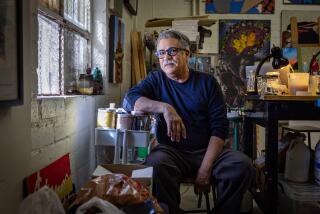AIDS at 20 years: Patients hope while fight goes on
What was once a near-automatic death sentence is now treatable. But AIDS still has no cure, and complacency and ignorance about the disease could put millions more at risk of being consumed by this unrelenting, global epidemic.
Twenty years ago, on June 5, 1981, the federal Centers for Disease Control issued its first alert to health departments of a rare, life-threatening infection in five young gay men in Los Angeles. Two were already dead.
Since then, almost 20 million have died. Thirty-five million more have been infected with HIV, the virus that causes AIDS. And according to the World Health Organization, more than 13 million children have been orphaned.
But survivors feel lucky, and sometimes inspired.
Now there is hope for the future, said Tamara Samantha Kuryla, 36, who has been living with the HIV virus for eight years. There is hope for quality of life beyond infection. There are new drugs. There are better services, medical and emotional.
There are long-term survivors to give you hope, said Kuryla, a former prostitute who is president of the People with AIDS Coalition of Broward County. When you see people who have lived for 23 years, you think, I can do that. In the beginning, it was six months and youre done. There was no hope.
In their 20th anniversary report on AIDS, released late last week, the CDC noted that despite much lower incidence rates among whites and Hispanics, the HIV virus is still spreading at an epidemic rate among black gay men.
Montgomery Hinds, a drug user who tested positive in 1993, is trying to help stop the spread.
Two years ago, tired of street life and knowing he had probably infected many people through unprotected sex, he changed his lifestyle.
He became an outreach worker for Broward House, which helped him return to sobriety. He is paid to find people like himself and persuade them to be tested and treated.
He takes condoms with him into the poorest neighborhoods, and yet most people refuse them, Hinds said.
Sometimes he repeats the message get tested for six months or a year to the same people before they come around.
When they do, he feels victorious.
I feel like I am doing my lifes work. I am doing something good, he said.
Though new drugs have been able to dramatically decrease death rates, there remains the great fear among AIDS experts of the kind of complacency Hinds finds on the streets.
When they see Magic Johnson doing so well, they dont think they have anything to worry about, said Dr. Margaret Fischl, professor of medicine and director of the AIDS Clinical Research Unit at the University of Miami School of Medicine/Jackson Memorial Hospital.
I tell them, You can get very sick, you can die. But these are young people. They dont remember what it was like. They think theyre immortal, and they dont want to think about death, said Fischl, whose work led to approval of the first AIDS drug, AZT.
Often exhausted by the physical and emotional demands of caring for dying patients and searching for new drugs that could help them, Fischl, 52, has continued her quest for better treatments.
Her patients have multiple combinations of drugs available. AZT, now called zidovudine, and its cousins are part of the arsenal, and may be used with a newer class of drugs, protease inhibitors, to attack the virus from different directions.
Trauma and stigma
In many cases, the virus is reduced to undetectable levels, but it is still there, lurking in hidden reservoirs in a dormant state, she said. When active, the virus continues to mutate, so Fischl and other clinician-researchers and scientists have to stay a step ahead.
We cant stop. We have to be on guard all the time, she said.
At the University of Miami School of Medicine/Jackson Memorial Hospital, physicians and staff say they have witnessed the deaths of 15,000 people with HIV since the epidemic began.
It was very difficult seeing so many patients die. It was very hard to do 15,000 deaths at a single medical center, Fischl said. That is not something physicians typically see.
Florida ranks third in the nation in adult AIDS cases, more than 75,000, and second in pediatric cases with about 1,400. Almost 40,000 Floridians have died from infections, cancers and complications because HIV destroyed their immune systems.
Kuryla, of the People with AIDS Coalition, also works as a counselor at the North Broward Hospital Districts Childrens Diagnostic and Treatment Center, helping families with HIV.
Her job is to tell HIV parents what they can expect. She goes to schools to talk about HIV, how to avoid it and what its like. She too is scared, she says, by the cavalier attitude she sees in young people.
Her own son will not have that luxury. Christian, 4, was born with HIV and has to take medications every day.
It wont affect Christian until the world gets ahold of him, she said. People will talk about his HIV, make him feel that he did something wrong. Im trying to make him strong for when that day comes.
Its great to see kids who were born with HIV and now are 20 years old and going to college, Kuryla said. Thats what I want him to see.
Dr. Gwendolyn B. Scott, a pediatrician at UM/Jackson has been caring for babies and children with AIDS since 1981. The terror surrounding the disease sometimes interfered with its treatment, Scott said.
Revealing the diagnosis to the family was always traumatic. Sometimes it took many hours to try to get them to understand, to calm them. All they could think about was that this was the death of their child, Scott said. It was a very trying situation for us, too, because we had to do this so many times, over and over.
Because people were very frightened by the disease, some patients were ousted out of their homes, put out into the streets because their families were afraid. There was a stigma, so some people didnt want to tell anyone they were infected, and many times they had almost no support.
Scott said she would write prescriptions to prevent the infections that plagued children with HIV, but they would soon be back in the emergency room.
We had families living in abandoned cars or abandoned buildings with no food, because they didnt have any support. They couldnt pay for their prescriptions, and the child got sicker, Scott said. Very early on we recognized the importance of social services as part of our comprehensive care.
Scott and her staff now have seven social workers as part of the team caring for 333 children with HIV, and another 200 kids who are going through the screening process to test for the virus.
Scotts work helped to prove that giving AZT to infected women during pregnancy can reduce the likelihood that the baby will be born infected from 25 percent to 8 percent.
That has dropped further, to only about 2 percent today.
In children who do become infected, the death rate also has dropped.
We used to have as many as 20-25 deaths a year. Now its no more than five or six, she said. At this point in 2001, were following about 80 teenagers who have had infections since birth. The oldest of those is 22 years of age.
Halting the spread
William Darrow, a public health professor at Florida International University, was working in the communicable diseases unit at the CDC in the spring of 1981.
Publication of those first cases in the CDCs Morbidity and Mortality Weekly Report on June 5, 1981, did not create much of a stir among the general public, Darrow said.
I think there was a small item in The New York Times, he said, but outside of the gay community, not many people were concerned.
Darrow, a research sociologist with knowledge about the gay community and expertise in tracking sexually transmitted diseases, was assigned to work with epidemiologists trying to pinpoint the cause.
This was first and foremost a medical mystery, he said.
He helped design a study that included 50 gay men who were sick and a group of about 200 gay men who were healthy, asking questions about lifestyle, diet and sexual practices.
The study found the major differences among the men were that those who were sick had multiple sexual partners.
That led us to believe it was sexually transmitted, said Darrow, whose work was chronicled in And The Band Played On, a book, and later a film, about the epidemic by journalist Randy Shilts.
Although Darrow left the CDC in 1994, he still fights the spread of the virus.
He has been examining why many young gay men in South Beach do not practice safe sex.
In Broward County, he and colleagues at FIU have received a CDC grant to design and carry out a prevention program in the 12 ZIP codes with the highest HIV infection rates.
The ultimate goal of course is to stop the spread of HIV, well achieve our mission when there is no longer any HIV being spread.
But 20 years into the epidemic, people still are not getting the message, he said.
They dont think it affects them or their communities. When we go into communities with prostitutes on the corner, and drug use, and ask. Is there any AIDS? They say, No, we dont have any AIDS here. Can you believe it in 2001? This was not an unusual response, Darrow said. We still have an awfully long ways to go.
Stacey Singer and Bob Lamendola contributed to this report.
More to Read
Get the L.A. Times Politics newsletter
Deeply reported insights into legislation, politics and policy from Sacramento, Washington and beyond. In your inbox three times per week.
You may occasionally receive promotional content from the Los Angeles Times.






